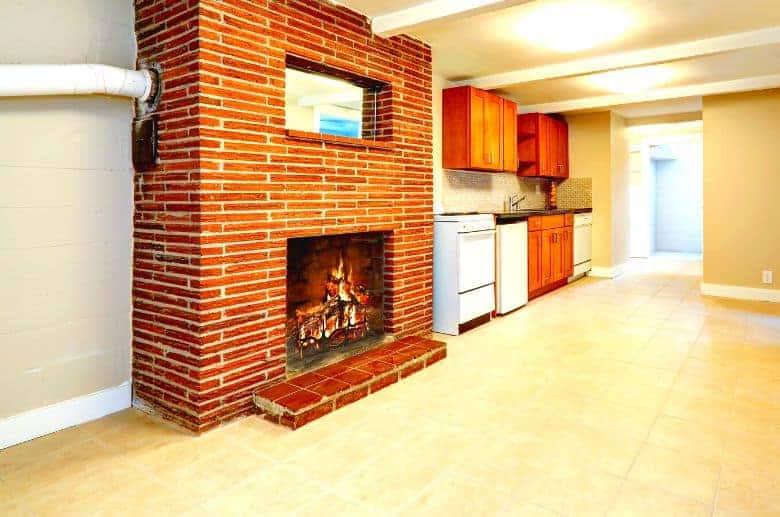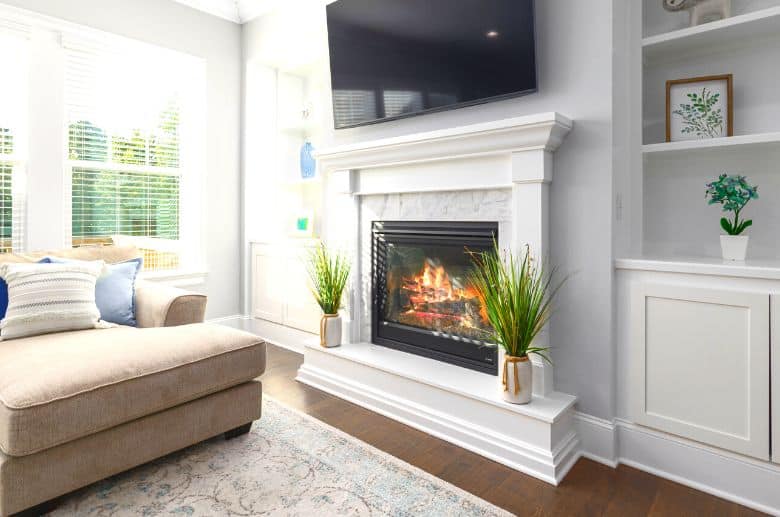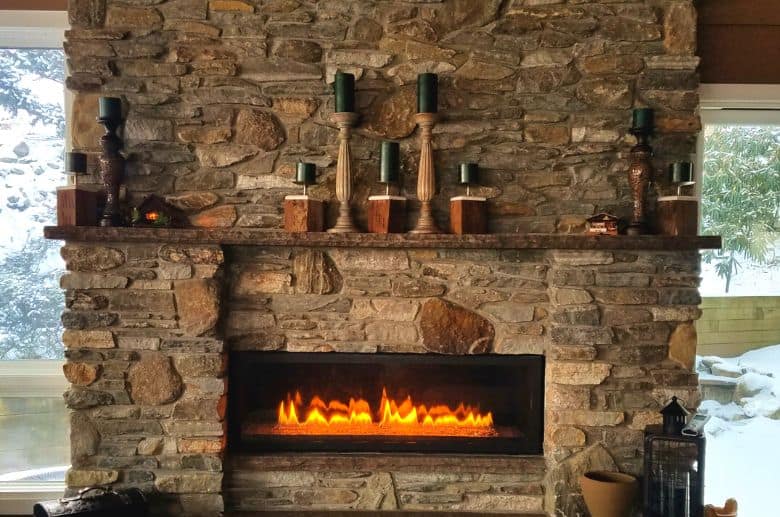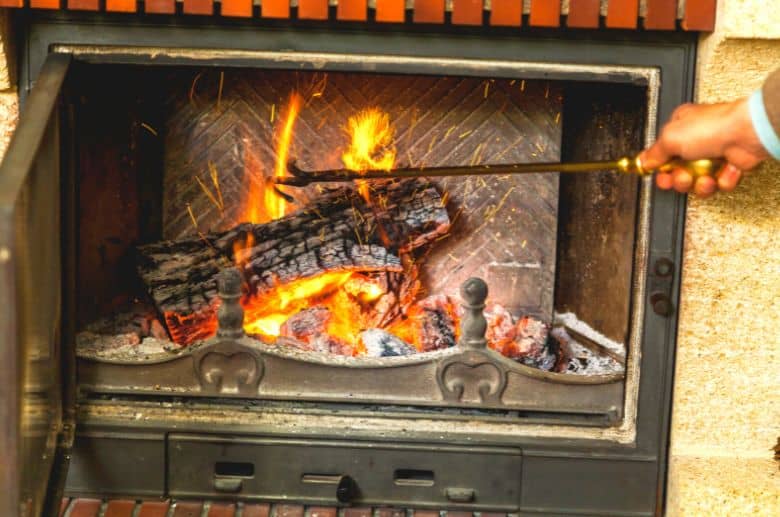The fireplace is the focal point of any home. It keeps your home warm and cozy during the freezing winter months and adds visual appeal.
There are two main types of fireplaces: masonry and prefab. If you are moving into a home, it is important to know what kind of fireplace it has.
This is because the two fireplace systems are made of different materials, and you need to know how to maintain them.
Knowing the fireplace types is also vital if you are considering upgrading your existing unit.
In this post, we will discuss masonry vs prefab fireplace differences. Keep reading to discover more.
What is the difference between masonry and prefabricated fireplace?
A masonry fireplace is built on-site. It is made of bricks or stones held together by mortar. On the other hand, a prefabricated fireplace is manufactured in the factory.
What is a masonry fireplace?

A masonry fireplace is made of bricks or stones bound by mortar. This is the oldest and most popular fireplace that will give your home a classical look.
It is built at the site and takes several days to install. So, it is an integral part of your home’s structure and requires professionals to construct it to prevent structural issues. The brick and mortar make up the whole unit, from the fireplace to the stack.
In most cases, the flue liner in most masonry fireplaces is made of clay tiles. A distinct feature of brick-and-mortar fireplaces is that they are durable and can last up to 100 years.
This, however, does not mean that masonry fireplaces are indestructible. Over time, the brick and mortar deteriorate and crumble due to exposure to elements like rainwater and ice.
What is a prefabricated fireplace?

A prefabricated fireplace, also known as a zero-clearance fireplace that is built at the factory.
All the components (the firebox, flue pipe, chimney cap, etc.) are premanufactured and assembled at homes.
Prefab fireplaces are typically made from metals like stainless steel, And tested for efficiency and safety by UL-listed companies. These tests ensure that the unit meets the required safety standards. So, you must follow the manufacturer’s instructions when installing a factory-built fireplace.
For instance, the manufacturer can advise against using different metals when replacing damaged components. Failure to follow instructions usually leads to issues such as early deterioration and inefficiency.
Remember, some prefabricated fireplaces are only designed to burn either gas or wood, while some models burn both. Prefab fireplaces generally last 20-30 years if well maintained.
——
Do You Need to Hire Chimney & Fireplace Expert?
Get free quotes from qualified experts near you. No commitment required!
——
How do I know if my fireplace is prefabricated or masonry
You can tell whether your fireplace is masonry or prefabricated by looking at what it’s made of. Masonry chimneys are made of brick or stone held together by mortar. On the other hand, prefab fireplaces are made of metal.
| Features | Masonry Fireplace | Prefabricated fireplace |
| Materials | Brick/stone and mortar. | Metal |
| Installation procedure | Installation is done onsite. Involves altering the home’s structure and can take a week. | Installation is easy as it’s basically assembling the premade components |
| Design | Visually appealing. Many homeowners look for the traditional chimney look | Not as visually appealing as a masonry fireplace |
| Ease of use | Starting a fire can be an issue, especially with a drafty fireplace | Easy to use as you can use gas logs which are turned on by a switch |
| Cleaning and maintenance | Requires regular cleaning and maintenance to remove dangerous elements like creosote and soot | Prefab units are much easier to clean than masonry ones |
| Efficiency | Warm your home but doesn’t retain much heat, especially if you don’t have a fireplace door | Burns cleaner and hotter. Uses less fuel |
| Cost | Costs $3500-$10000 to install. Expensive as it involves altering your home’s structure | The price of installation is $1000-$4000. Not costly since you do not need to make any structural changes to your home |
| Life expectancy | Can last up to 100 years. So it’s the more durable alternative | Usually lasts around 20-30 years. Not ideal if you are looking for a fireplace that will last a lifetime |
| Safety | Safe as long as you schedule yearly inspections and cleaning | Factory-tested for safety. Need annual inspections and cleaning. |
1. Materials
Masonry fireplaces are typically made with bricks/stones held together by mortar.
These materials are highly durable, and if you take care of your fireplace well, it will be decades before you notice signs of deterioration.
On the other hand, prefab fireplaces are made of metals like copper and stainless steel. These materials require replacement after about 20-30 years.
2. Installation procedure
The process of installing a prefab fireplace is simple.
All the components are premanufactured in the chimney and assembled in your home. The installation takes only a few hours.
On the other hand, Masonry fireplaces are usually built during a home’s construction.
Major structural changes must be made to install this fireplace in an existing house. Installation can take up to a week as it involves placing the necessary support structures as you build the entire unit.
3. Design

Many people opt for masonry fireplaces because they provide a timeless look. Some buyers only seek masonry fireplaces because they are visually appealing.
Also, you can design a masonry fireplace to blend with your home’s decor. You only need to ensure that your chimney sweep is experienced and capable of providing your desired design.
On the other hand, prefab fireplaces do not offer many customization options. You can add wood or brick sidings to the flue pipes to make them look like traditional fireplaces.
4. Ease of use
Prefab fireplaces work well with seasoned wood, gas, and prefabricated logs. Some models require you to use only one fuel type.
Prefab fireplaces are easier to use but ensure the fire is not too big as it can damage the refractory panels. If you are using gas logs, you can use a valve to control the height of the flames.
Masonry fireplaces are also easy to use as well. Starting a fire requires some skills, but it won’t be a problem once you have mastered it.

5. Cleaning and Maintenance
A masonry fireplace will not work well if you don’t do proper maintenance.
Over time, parts of your chimney, like the brick and mortar, flashing, and chimney crown, deteriorate because of exposure to rainwater and snow.
You should take action immediately if you notice common signs of damage, like spalling bricks and a cracked chimney crown.
Prefab fireplaces do not require much maintenance as it takes a while for creosote to accumulate in the metal lining.
Also, if a component is damaged, you can get a replacement from the manufacturer. While a prefab fireplace is a low maintenance compared to a masonry fireplace, you still need to schedule an annual professional cleaning.
——
Do You Need to Hire Chimney & Fireplace Expert?
Get free quotes from qualified experts near you. No commitment required!
——
6. Efficiency
When it comes to efficiency, a prefab fireplace has the edge over a masonry one. It is designed to burn cleaner and hotter while using less fuel.
In addition, prefab fireplaces are typically well-insulated, which makes them safe to install near combustibles.
A lot of heat from a masonry fireplace goes up the flue. So, when it comes to efficiency, a prefab fireplace is better than a masonry one.
7. Cost
Masonry fireplaces cost range anywhere from $3500-$10000, and the price varies depending on the size of the chimney, materials, and labor costs. A factory-built fireplace costs between $1000-$4000 to install as it doesn’t involve making structural changes to a home.
8. Life expectancy
A masonry fireplace lasts about 100 years, while a prefab lasts around 20-30 years.
This is because masonry chimneys are made of durable materials that can withstand high temperatures and exposure to different weather conditions.
9. Safety
Creosote can accumulate in both masonry and prefab fireplaces. If you don’t remove creosote, it can accumulate and block the flue, making it difficult for your chimney to exhaust smoke and fumes.
Creosote is highly flammable and can cause deadly chimney fires that can damage the chimney and your home.
Also, smoke and gasses like carbon monoxide can enter your home and cause nausea, fatigue, and other health issues.
The only way to ensure your fireplace is safe is to clean it, removing creosote, soot, and debris regularly.
A skilled chimney sweep should inspect and clean your masonry chimney at least once every year to ensure it lasts long.
Masonry fireplace Vs prefabricated the winner
As you can see, masonry and prefab fireplaces differ in many ways. Which fireplace wins? There’s no definitive answer. Some people prefer masonry fireplaces, while others go with prefab units.
If your house is under construction, it makes sense to install a masonry unit since it’s part of the structure. If you want to upgrade and are on a tight budget, a prefab fireplace will do the job.






